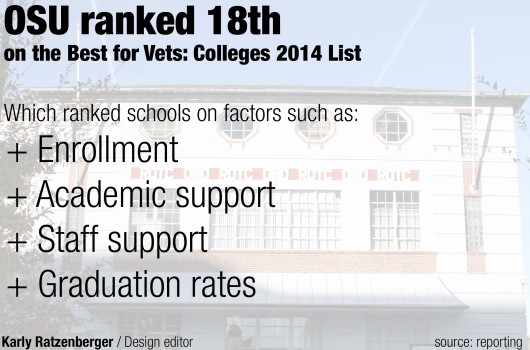After not making the cut last year, Ohio State was recently ranked one of the top 20 schools in the country for student-veterans.
OSU ranked 18th on the Military Times Best for Vets: Colleges 2014 list, which ranked schools based on factors such as enrollment, academic support, staff support, extracurriculars for student-veterans and graduation rates. Nearly 600 colleges applied to be considered to be ranked, according to Military Times.
Mike Carrell, director of the OSU Office of Military and Veterans Services, said getting on the list is particularly difficult.
“We are very happy to be announced as a part of this and one of the top schools there,” Carrell said. “This one is pretty selective.”
D’Youville College, a private college in Buffalo, N.Y., was ranked No. 1 on the list. University of Nebraska-Omaha, University of Wisconsin-Oshkosh, University of Wisconsin-Eau Claire, University of Michigan and University of Wisconsin-River Falls were among the other schools on the list, ranked at No. 2, No. 13, No. 38, No. 51 and No. 82, respectively, out of 86 schools.
Carrell said OSU, which has more than 2,000 student-veterans enrolled, made the list this year because an academic quality category was added to the survey.
“They added academic rigor this year to the calculation,” Carrell said. “That is one of the things we focused on entirely. All of our efforts that we started a couple of years ago that culminated with the new office opening (Office of Military and Veterans Services) a few years ago are focused on academic success as an organizing principle, so to get recognized and have that as part of it is even better.”
OSU received three and a half stars out of four for academic support and four stars for extracurricular opportunities, according to the list.
John Haviland, a second-year graduate student in computer science and engineering, former U.S. Marine Corps corporal and vice president of Vets 4 Vets, which aims to help student-veterans transition to campus life, said OSU and the Office of Military and Veterans Services deserve the ranking they received.
“That office takes care of their veterans … it is through their work that every single veteran has in-state tuition and all of our GI (Bill) payments are taken care of,” Haviland said.
The Post-9/11 GI Bill provides financial support for education and housing for student-veterans who served at least 90 days of aggregate service after Sept. 10, 2001, or who were discharged with a service-connected disability after 30 days, according to its website.
Carrell said the university did not make the cut last year because of some program changes.
“We did not get chosen last year, we were chosen the year before that,” Carrell said. “We did participate in the survey each year. Last year they changed some of the ratings (measures) … and we were coming out with new programs so they might not have counted them a lot since they were new.”
The resources that OSU provides student-veterans, including special academic advisers, factored into the ranking OSU received, Carrell said.
“We bring in other university employees right into our office to hold office hours,” Carrell said. “The students still have their academic advisers in their college but also have access to other advisers that are trained in university exploration.”
Haviland said student organizations also help welcome and recognize veterans.
“I have seen overwhelming support from other student organizations, for instance, Block ‘O,’” Haviland said. “They invited a bunch of student-veterans to come sit with them during the military appreciation football game. Ohio State recognizes their veterans. They know that we are here, and they try to take care of them the best that they can.”
The Office of Military and Veterans Services also works to emphasize what the students can offer in a classroom setting, Carrell said.
“Student-veterans are a great resource for you in the classroom,” Carrell said. “These folks are coming out with great experiences around the world. They have traveled around the world, lived in foreign cultures and they have been in high stress situations like combat … other students can benefit from their world experience.”
Anthony Hill, a fourth-year in neuroscience, petty officer third class in the U.S. Navy and student-veteran community advocate, which is a new program that seeks to help develop outreach programs and assist student-veterans in various ways, said he did not look at the military-friendly rankings before coming to OSU.
“Honestly I didn’t even think about veterans and school rankings before I came to Ohio State,” Hill said. “I can tell you as soon as I got to Ohio State, I was flooded with information from the OSU Veterans Affairs office … OSU quickly identified that I was a veteran and quickly sent me a lot of information that pertained to transitioning to becoming a full-time student.”
Carrell said the ranking and other similar ranking systems can help increase enrollment of student-veterans at OSU.
Hill agreed.
“Veterans are going to start seeing these rankings, especially veterans that are from Ohio are going to move back from Ohio, look at the different schools and these rankings and make a decision off of that,” Hill said. “The high ranking of Ohio State is going to have a serious increase in the number of veterans coming to OSU.”
Carrell said the entire OSU community contributes to the success of student veterans.
“No one office should own veterans on campus,” Carrell said. “Every office makes a critical contribution towards the success of student-veterans, and we are starting to see that … it’s about showing the student-veterans that we are serious about helping them.”



